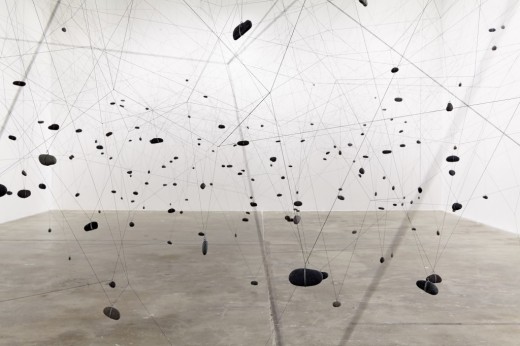 Gustavo Pérez Monzón, Vilos, 1981/2015. Photo: Perocles Lavat, courtesy CIFO
Gustavo Pérez Monzón, Vilos, 1981/2015. Photo: Perocles Lavat, courtesy CIFO
DECEMBER 2, 2015–MAY 1, 2016
In 1989, Cuban artist Gustavo Pérez Monzón abandoned his dynamic creative practice and moved to Mexico. Last year, Cubans rediscovered seventy of his works from the 1980s in a solo exhibition during the 2015 Havana Biennial. Presented first at El Museo Nacional de Bellas Artes, Tramas (Frames) traveled to the Cisneros Fontanals Art Foundation (CIFO), Miami.
When he made the work featured in Tramas, Pérez Monzón was at his most prolific. The outcome of his mathematical art experiments ranges from temporary spatial interventions made of string, wire, thread, and vinyl to intricate numbered drawings on cardboard, dark-hued Expressionist paintings, and a set of handmade silver tarot cards. The evidence of process is Conceptualist. The materials point to arte povera and Minimalism (he names Sol LeWitt, Carl Andre, and Richard Long as influences). The cards are just one example of the artist’s belief in numerology and his love for what he calls a “complex system of meanings that can be articulated from different points of view.”
What’s fascinating for me is that twice in the space of one year, in two distinctive art venues, Pérez Monzón recreated three of the site-specific, labor-intensive installations he’d first realized in Cuba more than twenty years ago. He effectively reunited with his younger self, by reenacting an artistic process in which he was once fully engaged.
My introduction to these works took place in a sweat-drenched crowd, on a stupifyingly hot night during the opening days of the biennial. I especially remember circling the periphery of one installation, gazing through it, and pondering its mysterious physics. That was Vilos (1981/2015), a room-size constellation of wire and elastic thread, held in place by small gray stones.
In Miami, I revisited the exhibition at CIFO, where the art seems to have more breathing room. Perhaps I got that impression because I was there on a quiet Sunday morning. In any case, the beautiful Vilos has definitely expanded up and out, hovering so close to the walls of the gallery that viewers are not permitted to enter.
The site-specific vinyl line drawing Tramas (1989/2015) that spanned a long, free-standing rectangular wall in Havana also grew up when it moved to Miami. Here, Pérez Monzón has doubled the dimensions of the jagged gray matrix. Tramas stretches down one wall and around an inside corner near the entrance.
Threads (1984/2015) also seems larger at CIFO, but I’m told that’s an illusion. In both venues, the artist rendered the same precisely calculated composition of parallel and intersecting lines in crimson thread on a white wall, anchoring each angle with a tiny square of dark red tape.
I can’t help thinking about how the exhibition demonstrates the intrinsic role that collectors play in validating artists and shaping art history. Ella Fontanals-Cisneros has collected and will preserve a decade of this Cuban artist’s work. The exhibition encapsulates a time in Pérez Monzón’s creative life when the freedom to explore was the greatest reward. It’s easy to understand how he became somewhat of a mythical figure in the Cuban art scene. The work transcends the moment in which it was made, standing outside a troubled economy, ignoring a dissipating sense of community, and refusing any doubt as to the value of making art.









